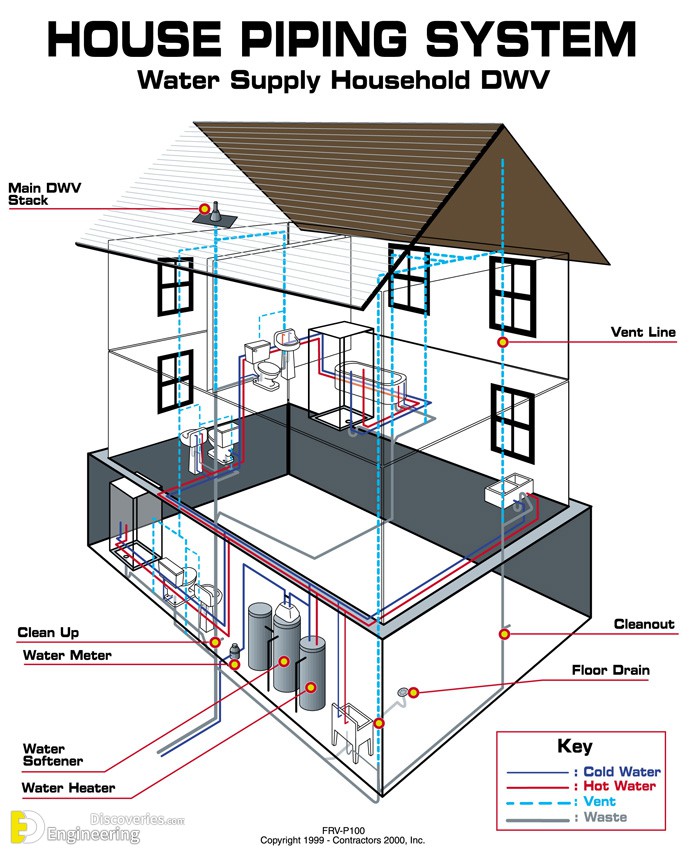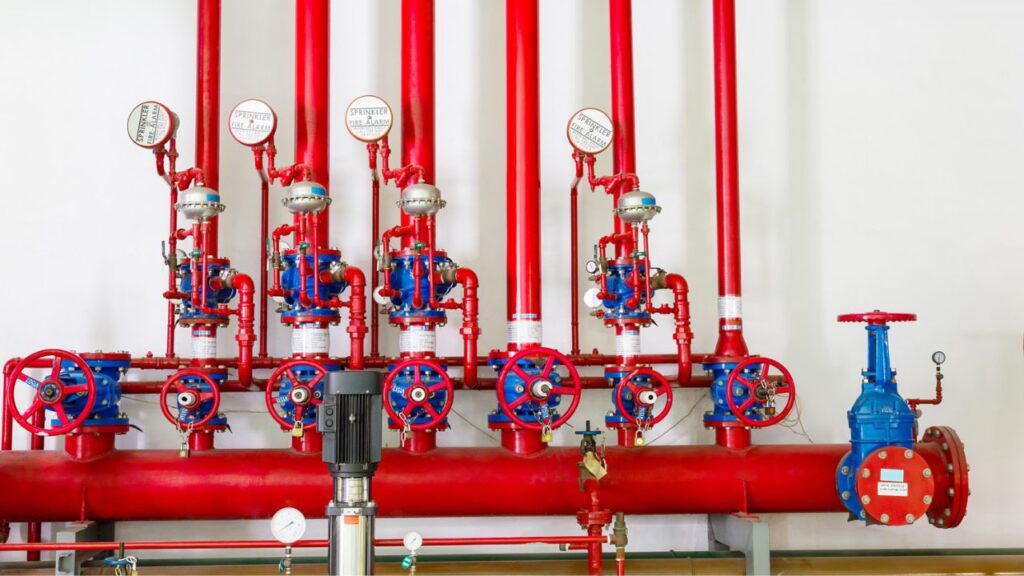Everything You Need to Know to Your Home's Plumbing System Anatomy
Everything You Need to Know to Your Home's Plumbing System Anatomy
Blog Article
Each person maintains their own unique assumption when it comes to Anatomy of a House: Understanding the Components.

Understanding exactly how your home's pipes system works is vital for each property owner. From providing clean water for drinking, food preparation, and bathing to safely removing wastewater, a well-maintained pipes system is important for your family's health and wellness and comfort. In this extensive overview, we'll discover the detailed network that makes up your home's pipes and deal suggestions on maintenance, upgrades, and handling usual concerns.
Intro
Your home's pipes system is more than simply a network of pipelines; it's a complicated system that ensures you have accessibility to clean water and reliable wastewater elimination. Understanding its components and just how they collaborate can assist you avoid costly fixings and make sure whatever runs smoothly.
Standard Parts of a Plumbing System
Pipelines and Tubing
At the heart of your pipes system are the pipelines and tubing that lug water throughout your home. These can be made of numerous products such as copper, PVC, or PEX, each with its advantages in regards to toughness and cost-effectiveness.
Fixtures: Sinks, Toilets, Showers, and so on.
Components like sinks, commodes, showers, and tubs are where water is used in your house. Recognizing exactly how these fixtures link to the plumbing system assists in detecting troubles and preparing upgrades.
Valves and Shut-off Factors
Shutoffs manage the flow of water in your pipes system. Shut-off valves are critical during emergency situations or when you need to make repairs, enabling you to isolate parts of the system without disrupting water flow to the whole house.
Water System
Main Water Line
The major water line connects your home to the municipal water system or a private well. It's where water enters your home and is distributed to numerous fixtures.
Water Meter and Pressure Regulator
The water meter procedures your water use, while a stress regulator makes sure that water flows at a risk-free stress throughout your home's pipes system, protecting against damage to pipes and fixtures.
Cold Water vs. Warm water Lines
Understanding the difference in between cold water lines, which supply water straight from the major, and hot water lines, which carry heated water from the water heater, helps in fixing and planning for upgrades.
Drain System
Drain Pipes Water Lines and Traps
Drain pipelines carry wastewater away from sinks, showers, and commodes to the sewage system or septic tank. Traps avoid drain gases from entering your home and additionally catch particles that might create obstructions.
Air flow Pipelines
Air flow pipes enable air right into the drainage system, protecting against suction that can slow drainage and create traps to vacant. Correct air flow is essential for maintaining the honesty of your pipes system.
Relevance of Correct Drain
Making sure appropriate drain avoids backups and water damage. Regularly cleaning drains pipes and keeping catches can protect against pricey repairs and extend the life of your pipes system.
Water Heating System
Types of Hot Water Heater
Water heaters can be tankless or traditional tank-style. Tankless heaters heat water as needed, while containers keep heated water for prompt usage.
Exactly How Water Heaters Connect to the Plumbing System
Comprehending how hot water heater link to both the cold water supply and hot water circulation lines assists in diagnosing concerns like inadequate warm water or leakages.
Maintenance Tips for Water Heaters
Regularly purging your water heater to remove debris, examining the temperature level settings, and checking for leakages can extend its life-span and improve energy efficiency.
Usual Plumbing Concerns
Leaks and Their Reasons
Leakages can happen due to maturing pipelines, loose installations, or high water stress. Addressing leaks quickly protects against water damages and mold development.
Blockages and Blockages
Blockages in drains and bathrooms are typically triggered by purging non-flushable products or a buildup of grease and hair. Using drain screens and bearing in mind what decreases your drains pipes can avoid blockages.
Indicators of Plumbing Troubles to Look For
Low tide pressure, slow-moving drains, foul odors, or unusually high water expenses are signs of prospective plumbing issues that need to be resolved immediately.
Pipes Maintenance Tips
Normal Evaluations and Checks
Set up annual pipes inspections to capture concerns early. Search for indicators of leaks, rust, or mineral accumulation in taps and showerheads.
DIY Maintenance Tasks
Straightforward tasks like cleansing tap aerators, looking for commode leakages using dye tablets, or protecting revealed pipes in cool climates can avoid significant pipes issues.
When to Call an Expert Plumber
Know when a pipes concern requires expert expertise. Attempting complicated fixings without correct expertise can lead to more damage and greater fixing prices.
Upgrading Your Pipes System
Factors for Upgrading
Upgrading to water-efficient components or changing old pipes can improve water quality, minimize water expenses, and raise the worth of your home.
Modern Plumbing Technologies and Their Benefits
Check out modern technologies like clever leakage detectors, water-saving commodes, and energy-efficient water heaters that can save money and decrease ecological effect.
Expense Factors To Consider and ROI
Compute the ahead of time prices versus lasting cost savings when considering plumbing upgrades. Many upgrades pay for themselves through reduced energy expenses and fewer repair services.
Ecological Effect and Conservation
Water-Saving Fixtures and Devices
Mounting low-flow taps, showerheads, and bathrooms can substantially minimize water usage without compromising efficiency.
Tips for Decreasing Water Usage
Easy habits like fixing leaks without delay, taking much shorter showers, and running complete lots of laundry and recipes can preserve water and lower your utility expenses.
Eco-Friendly Plumbing Options
Consider sustainable pipes products like bamboo for flooring, which is durable and eco-friendly, or recycled glass for counter tops.
Emergency situation Readiness
Actions to Take Throughout a Plumbing Emergency
Know where your shut-off valves are located and just how to shut off the supply of water in case of a burst pipeline or major leak.
Importance of Having Emergency Situation Get In Touches With Useful
Keep call information for local plumbing professionals or emergency situation solutions conveniently offered for quick feedback throughout a plumbing crisis.
Do It Yourself Emergency Fixes (When Applicable).
Short-lived repairs like utilizing duct tape to spot a dripping pipeline or putting a bucket under a leaking tap can decrease damage until a specialist plumbing technician gets here.
Verdict.
Comprehending the composition of your home's pipes system equips you to keep it efficiently, conserving time and money on repair work. By adhering to routine upkeep routines and remaining educated about modern plumbing modern technologies, you can ensure your pipes system runs effectively for several years to come.
Understanding Your Home Plumbing System: A Comprehensive Guide
Plumbing System: The Lifeline of Your Home
At its core, the plumbing system is designed to perform two primary functions: bring fresh water into your home and remove wastewater. The system is a network of pipes, fixtures, and other components that transport water and sewage. Residential plumbing systems include potable water supply lines, drain-waste-vent (DWV) systems, and various plumbing fixtures that make water use in daily tasks possible.
Key Components:
Water Supply: This part of your plumbing system brings municipal water into your home, passing through the main water supply line. It s responsible for supplying all water needs, from drinking to bathing.
Drainage System: It carries waste and water away from your home to the sewer or septic system. This system includes all the piping within your home that leads to external sewage or septic systems.
Vent System: An essential yet often overlooked component, the vent system allows sewer gases to escape and lets air into the drainpipes, ensuring water and waste move correctly through the system.
Fixture: More Than Just Taps and Toilets
Plumbing fixtures are the most interactive parts of the plumbing system, including faucets, showers, toilets, and sinks. Each fixture is connected to the plumbing system and plays a role in either the delivery of freshwater or the disposal of waste and wastewater.
Types of Fixtures:
Faucets and Sinks: Used for washing hands, dishes, and other daily water needs.
Toilets: Dispose of human waste through the sewage system.
Bathtubs and Showers: Provide bathing facilities, requiring both hot and cold water supply.
Water Supply: The Source of Life
The water supply system is a critical component, ensuring that potable water is available throughout your home for various uses, including drinking, cooking, and cleaning. This system consists of pipes that distribute water to different parts of the house, controlled by valves to regulate the water flow.
Types of Plumbing: Materials and Methods
Various types of plumbing systems and materials are used in residential settings, each with its advantages and applications. From copper and PVC pipes for water supply to cast iron and ABS for drainage, the choice of materials can impact the longevity and efficiency of your plumbing system.
https://intownplumbingtx.com/articles/home-plumbing-system-guide/

Understanding Your Home Plumbing System: A Comprehensive Guide
Plumbing System: The Lifeline of Your Home
At its core, the plumbing system is designed to perform two primary functions: bring fresh water into your home and remove wastewater. The system is a network of pipes, fixtures, and other components that transport water and sewage. Residential plumbing systems include potable water supply lines, drain-waste-vent (DWV) systems, and various plumbing fixtures that make water use in daily tasks possible.
Key Components:
Water Supply: This part of your plumbing system brings municipal water into your home, passing through the main water supply line. It s responsible for supplying all water needs, from drinking to bathing.
Drainage System: It carries waste and water away from your home to the sewer or septic system. This system includes all the piping within your home that leads to external sewage or septic systems.
Vent System: An essential yet often overlooked component, the vent system allows sewer gases to escape and lets air into the drainpipes, ensuring water and waste move correctly through the system.
Fixture: More Than Just Taps and Toilets
Plumbing fixtures are the most interactive parts of the plumbing system, including faucets, showers, toilets, and sinks. Each fixture is connected to the plumbing system and plays a role in either the delivery of freshwater or the disposal of waste and wastewater.
Types of Fixtures:
Water Supply: The Source of Life
The water supply system is a critical component, ensuring that potable water is available throughout your home for various uses, including drinking, cooking, and cleaning. This system consists of pipes that distribute water to different parts of the house, controlled by valves to regulate the water flow.
Types of Plumbing: Materials and Methods
Various types of plumbing systems and materials are used in residential settings, each with its advantages and applications. From copper and PVC pipes for water supply to cast iron and ABS for drainage, the choice of materials can impact the longevity and efficiency of your plumbing system.
https://intownplumbingtx.com/articles/home-plumbing-system-guide/
I am very interested in Anatomy of a House: Understanding the Components and I am assuming you enjoyed reading the entire post. Sharing is good. Who knows, you may just be doing someone a favor. Thanks so much for going through it.
About Report this page